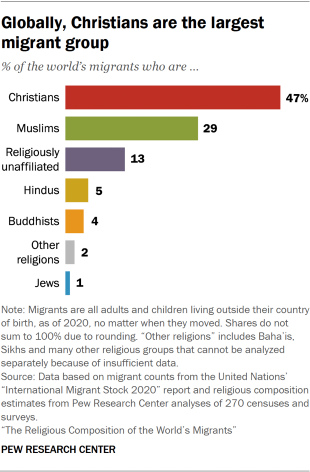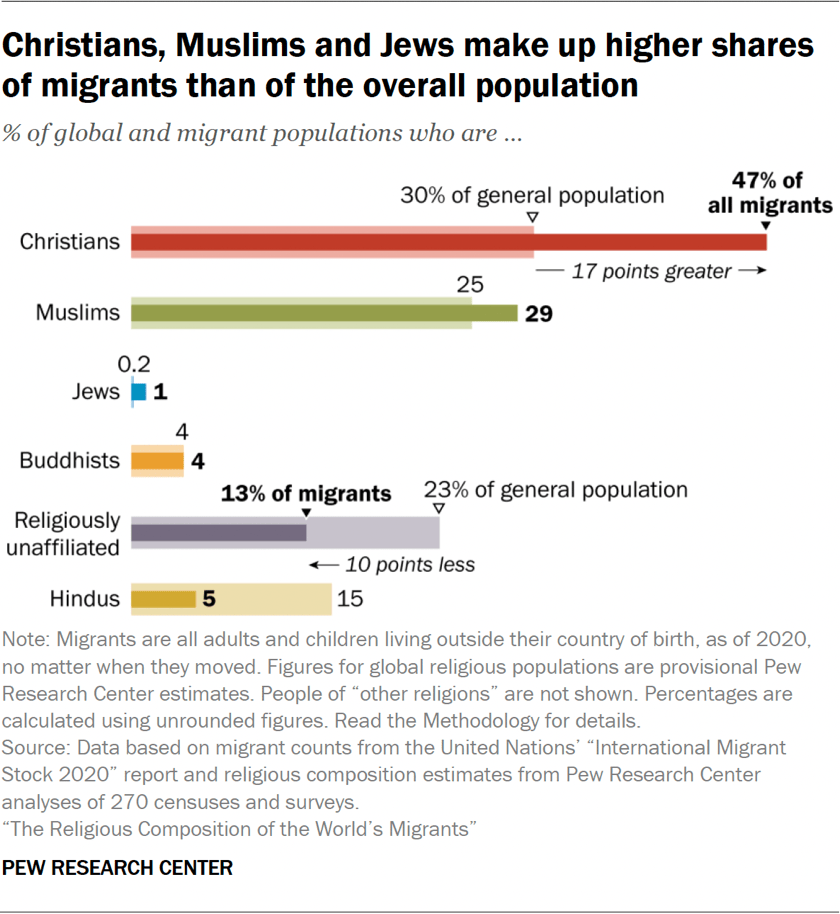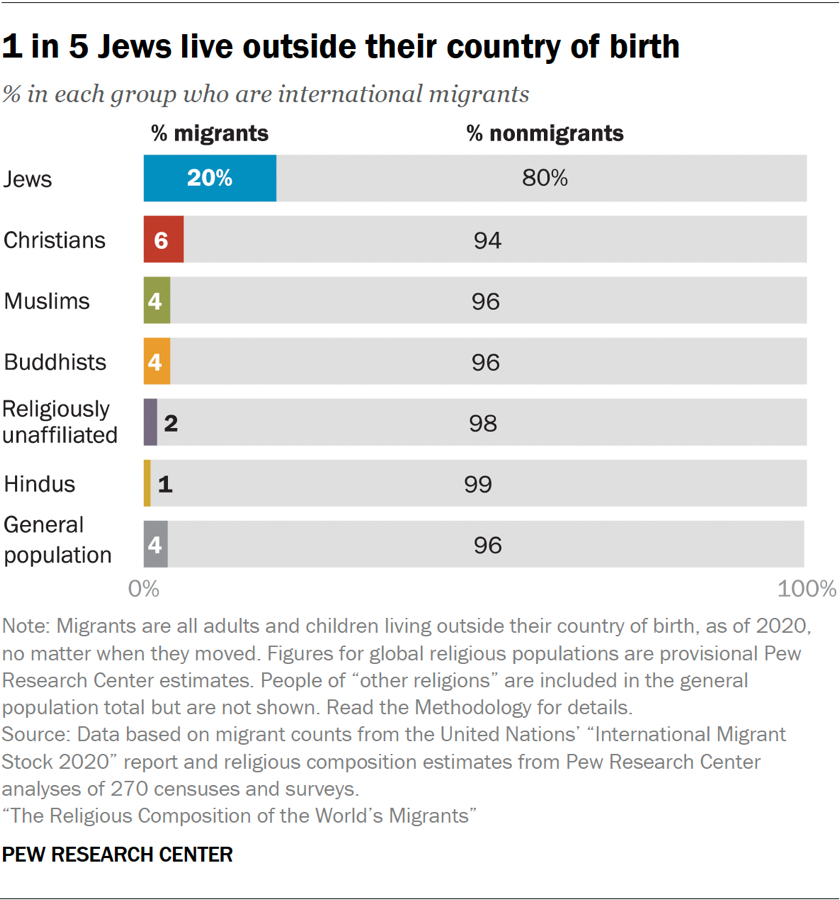World
The Religious Composition of the World’s Migrants

Christians are the largest migrant group, but Jews are most likely to have migrated
For this report, we gathered data on existing “stocks” of international migrants – all adults and children who now live outside their birth country, no matter when they left. (This report does not estimate migration “flows” – how many people move across borders in any single year.)
Our goal was to describe the religious composition of international migrants – how many are Buddhist, Christian, Hindu, Jewish and Muslim – and how many have no religion, including atheists and agnostics. We did not analyze patterns for other religious groups, such as Baha’is and Sikhs, because censuses in many countries do not provide data about them.
Our migrant counts are based on hundreds of national censuses, surveys and other data sources. We began with the most recent migrant stock estimates from the United Nations Population Division, for 1990-2020. The UN figures show where international migrants have come from (i.e., their origin countries or territories) and where they have ended up (i.e., their destination countries or territories). But the UN does not provide any information on their religion.
To estimate the religious identities of migrants, we drew primarily on data from 270 censuses and surveys – such as the World Values Survey, European Social Survey and Pew Research Center surveys – conducted where migrants now live.
When countries had insufficient survey or census data on the religion of migrants, we typically turned to information about migrants living in similar geographic and religious contexts. For example, in surveys of Belgium, there are too few migrants from Syria to estimate their religious composition. So we drew on surveys of Syrians living in other European countries where Christians are the largest religious group.
Using these methods, we estimated the religious composition of 98% of the world’s international migrants. For the remaining 2% of migrants, we assumed that their composition matched the religious composition of their origin country.
Altogether, we estimated the religious composition of migrants from 95,696 combinations of 232 origin and destination countries and territories. The other routes had no known migrants.
Here is the full Methodology.
The United Nations counts international migrants as people of any age who live outside their country (or in some cases, territory) of birth – regardless of their motives for migrating, their length of residence or their legal status.
In addition to naturalized citizens and permanent residents, the UN’s international migrant numbers include asylum-seekers and refugees, as well as people without official residence documents. The UN also includes some people who live in a country temporarily – like some students and guest workers – but it does not include short-term visitors like tourists, nor does it typically include military forces deployed abroad.
For brevity, this report refers to international migrants simply as migrants. Occasionally, we use the term immigrants to differentiate migrants living in a destination country from emigrants who have left an origin country. Every person who is living outside of his or her country of birth is all three – a migrant, an immigrant and an emigrant.
The analysis in this report focuses on existing stocks of international migrants – all people who now live outside their birth country, no matter when they left. We do not estimate migration flows – how many people move across borders in any single year.
Migration has grown steadily in recent decades. Today, more than 280 million people, or 3.6% of the world’s population, are international migrants – meaning they live outside their country of birth.

Christians made up an estimated 47% of all people living outside their country of birth as of 2020, the latest year for which global figures are available, according to a new Pew Research Center analysis of United Nations data and 270 censuses and surveys.
Muslims accounted for 29% of all living migrants, followed by Hindus (5%), Buddhists (4%) and Jews (1%).
The religiously unaffiliated – i.e., those who say they have no religion, or who identify as atheist or agnostic – represented 13% of all the people who have left their country of birth and are now living elsewhere.
Over the past three decades, the total number – or stock – of people living as international migrants has increased by 83%, outpacing global population growth of 47%.
This report focuses on stocks rather than flows of migrants. We are counting all adults and children who now live outside their countries of birth, no matter when they left.
We are not trying to estimate how many move in a single year.
While the religious makeup of migration flows can change drastically from year to year – due to wars, economic crises and natural disasters – the total stock of migrants changes more slowly, reflecting patterns that have accumulated over time.
The religious makeup of all international migrants has remained relatively stable since 1990.
Our analysis finds:


- Christians make up a much larger share of migrants (47%) than they do of the world’s population (30%). Mexico is the most common origin country for Christian migrants, and the United States is their most common destination.
- Muslims account for a slightly larger share of migrants (29%) than of the world’s population (25%). Syria is the most common origin country for Muslim migrants, and Muslims often move to places in the Middle East-North Africa region, like Saudi Arabia.
- People without a religion make up a smaller percentage of migrants (13%) than of the global population (23%). China is the most common origin country for religiously unaffiliated migrants, and the U.S. is their most common destination.
- Hindus are starkly underrepresented among international migrants (5%) compared with their share of the global population (15%). India is both the most common country of origin and the top destination for Hindu migrants.
- Buddhists make up 4% of the world’s population and 4% of its international migrants. Myanmar (also called Burma) is the most common origin country for Buddhist migrants, while Thailand is their most common destination.
- Jews form a much larger share of migrants (1%) than of the world’s population (0.2%). Israel is the most frequent origin country among Jewish migrants and also their top destination.
- Of the major religious groups, Jews are by far the likeliest to have migrated. One-in-five Jews reside outside of their country of birth, compared with smaller shares of Christians (6%), Muslims (4%), Hindus (1%), Buddhists (4%) and the religiously unaffiliated (2%).
How religion is connected with migration
People move internationally for many reasons, such as to find jobs, get an education or join family members. But religion and migration are often closely connected.
Many migrants have moved to escape religious persecution or to live among people who hold similar religious beliefs. Often people move and take their religion with them, contributing to gradual changes in their new country’s religious makeup. Sometimes, though, migrants shed the religion they grew up with and adopt their new host country’s majority religion, some other religion or no religion.
While the migration patterns of religious groups differ, the groups in this analysis also have a lot in common. For example, migrants frequently go to countries where their religious identity is already prevalent: Many Muslims have moved to Saudi Arabia, while Jews have gravitated toward Israel. Christians and religiously unaffiliated migrants have the same top three destination countries: the U.S., Germany and Russia.
And, regardless of their religion, migrants often move from relatively poor or dangerous places to countries where they hope to find prosperity and safety.
These are among the key findings of a Pew Research Center analysis of international migrants around the world. The study is part of the Pew-Templeton Global Religious Futures project, which seeks to understand global religious change and its impact on societies.
The rest of this report contains chapters on:
Migration since 2020
This report relies on UN estimates of stocks of international migrants around the world for 1990, 2020 and every five-year interval between.
In 2020, the COVID-19 pandemic severely restricted travel, causing a precipitous drop in migration. But movement has picked up since, and there have been some sharp shifts in migration flow patterns. For example, emigration from Ukraine has surged due to its war with Russia.
Even though this report does not include very recent migration, we do not expect that recent events have had much impact on the religious composition of migrants overall. Even large flows of people leaving a country become part of much larger stocks of migrants who have already left, and the characteristics of these stocks tend to change very slowly.








